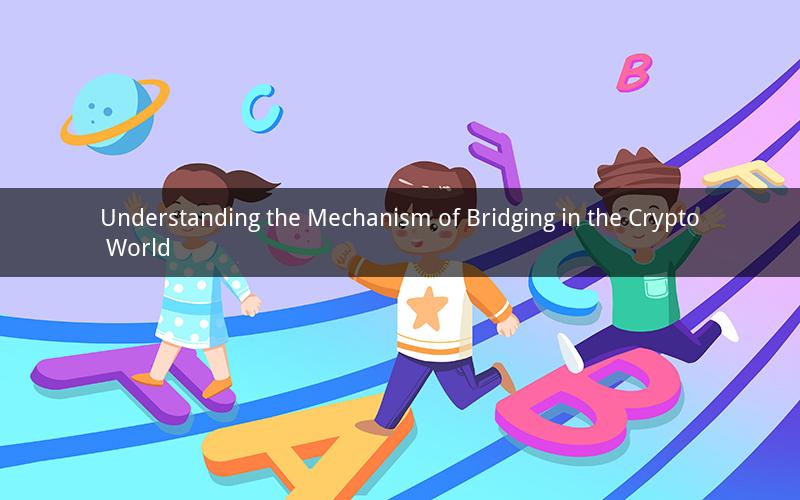
In the rapidly evolving world of cryptocurrencies, bridging has emerged as a crucial concept that facilitates the seamless transfer of value across different blockchain networks. Bridging allows users to move assets from one blockchain to another while maintaining their value and ensuring security. This article delves into the intricate workings of bridging in the crypto space, exploring its significance, mechanisms, and potential challenges.
1. What is bridging in crypto?
Bridging refers to the process of transferring assets from one blockchain to another. It enables users to access decentralized applications (DApps) and services across different networks while maintaining the value of their assets. Bridging is essential for achieving interoperability between blockchains, which is a key factor in the growth and adoption of cryptocurrencies.
2. How does bridging work?
Bridging operates through a combination of smart contracts, oracles, and liquidity pools. Here's a simplified explanation of the process:
a. User initiates a transfer: The process begins when a user decides to transfer their assets from one blockchain to another. They can do this by interacting with a bridging protocol, which is a set of smart contracts designed to facilitate the transfer.
b. Smart contracts verify the transfer: Once the user initiates the transfer, the bridging protocol's smart contracts verify the transaction. They ensure that the sender has the required assets and that the recipient's address is valid.
c. Oracles provide real-time data: Oracles play a crucial role in bridging by providing real-time data about the value of assets across different blockchains. This data is essential for maintaining the value of transferred assets during the bridging process.
d. Liquidity pools facilitate the transfer: Liquidity pools are pools of assets that are used to facilitate the bridging process. When a user wants to transfer assets, they can do so by swapping their assets for the equivalent value in the target blockchain's native currency. This process ensures that the value of the transferred assets remains consistent.
e. Recipient receives the assets: Once the bridging process is complete, the recipient receives the transferred assets in their wallet. They can now access decentralized applications and services on the target blockchain.
3. Benefits of bridging
Bridging offers several benefits to the crypto ecosystem:
a. Interoperability: Bridging enables interoperability between different blockchains, allowing users to access a wider range of applications and services.
b. Enhanced security: By utilizing smart contracts and oracles, bridging ensures the security of transferred assets, reducing the risk of fraud and theft.
c. Increased liquidity: Bridging increases the liquidity of assets by allowing users to transfer them across different blockchains, making it easier to trade and invest in cryptocurrencies.
d. Lower transaction costs: Bridging can lead to lower transaction costs, as users can transfer assets directly between blockchains without the need for intermediaries.
4. Challenges of bridging
Despite its numerous benefits, bridging also presents some challenges:
a. Centralization: Some bridging protocols rely on oracles, which can be centralized and susceptible to manipulation. This raises concerns about the security and reliability of the bridging process.
b. Slippage: Slippage occurs when the price of an asset changes between the time a user initiates a transfer and the time the transfer is completed. This can lead to discrepancies in the value of transferred assets.
c. Scalability: As the number of bridging protocols and users increases, scalability becomes a concern. Ensuring that the bridging process can handle a large number of transactions without compromising security and efficiency is a significant challenge.
d. Regulatory concerns: The regulatory landscape surrounding bridging is still evolving, and some jurisdictions may impose restrictions on the process, potentially hindering its adoption.
5. Future of bridging in crypto
The future of bridging in the crypto world looks promising. As the industry continues to mature, we can expect to see the following developments:
a. Improved security: Innovations in smart contract technology and oracle solutions will enhance the security of bridging protocols, reducing the risk of fraud and theft.
b. Increased adoption: As more users and developers become aware of the benefits of bridging, its adoption is likely to grow, further promoting interoperability between blockchains.
c. Enhanced scalability: Advances in blockchain technology will enable bridging protocols to handle a larger number of transactions without compromising security and efficiency.
d. Regulatory clarity: As regulators gain a better understanding of bridging, we can expect clearer guidelines and regulations to emerge, fostering the growth of the crypto industry.
In conclusion, bridging is a crucial concept in the crypto world that enables the seamless transfer of assets across different blockchains. By understanding the mechanisms and benefits of bridging, users can take advantage of the growing interoperability and liquidity in the crypto ecosystem. As the industry continues to evolve, bridging will play an increasingly important role in shaping the future of cryptocurrencies.
Questions and Answers:
1. What are oracles, and how do they contribute to the bridging process?
Answer: Oracles are services that provide real-time data about the value of assets across different blockchains. They play a crucial role in bridging by ensuring that the value of transferred assets remains consistent during the bridging process.
2. How does bridging help in reducing transaction costs?
Answer: Bridging allows users to transfer assets directly between blockchains without the need for intermediaries, which can lead to lower transaction costs compared to traditional cross-chain transactions.
3. What are the potential risks associated with centralized oracles in bridging protocols?
Answer: Centralized oracles can be susceptible to manipulation, which can compromise the security and reliability of the bridging process. This raises concerns about the integrity of transferred assets.
4. How does bridging contribute to the scalability of the crypto ecosystem?
Answer: Bridging protocols enable users to transfer assets across different blockchains, which can help alleviate congestion on individual networks and contribute to the overall scalability of the crypto ecosystem.
5. What are the main regulatory challenges faced by bridging protocols?
Answer: Regulatory challenges include ensuring compliance with existing regulations, navigating the evolving regulatory landscape, and addressing concerns about the security and transparency of bridging protocols.